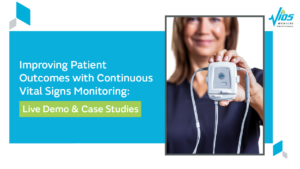
Positively impact patient care during capacity and staffing challenges
Remote, continuous patient monitoring for vital signs helps to improve patient care and efficiency of staff
By Angela Ethridge, MBA, MS, BSN
Sr. Director, Commercial Ops & Clinical Transformation
Murata Vios
Many healthcare facilities throughout the world are being challenged with hiring trained staff to care for and oversee patient care.
Nurses make up a large portion of the workforce within the healthcare profession and are critical to the care and safety of patients. The latest statistics have shown in the post-pandemic environment there is a shortage of nurses to provide care, and many of those who are working in healthcare facilities are overseeing a greater number of patients. With the growing number of elderly patients and increasing numbers of chronic medical conditions being admitted to facilities, this creates a challenge to ensure patient safety throughout the course of an admission.
With patient safety at the top of the list for most organizations, there is an ongoing dialogue among leadership to find new ways of providing care while always maintaining the safest environment for the patient.
These facilities are being pressed to care for more patients, often beyond bed capacity. To overcome capacity challenges, facilities are taking creative measures, transforming patient holding areas and corridor hallways into observation units and emergency rooms until a doctor or other clinical professional can assess, diagnose, and provide treatment. Either the patient will be safely discharged to home or admitted to a room for inpatient care.
Vital signs monitoring technology improves efficiency in patient care
New technologies in healthcare continue to drive improved efficiency in how caregivers care for patients. Wearable, wireless vital sign devices are on the rise in popularity with data flowing to a central location being monitored by qualified teams. If a change in vital signs occur, the staff will escalate this information to the bedside clinician for further assessment.
While each nurse is caring for a higher number of patients, these new technologies can assist the care team with the oversight needed during care transitions.
One of these technologies that can simplify the movement of patients throughout the care facility and assist the care team in times of staffing constraints is the Vios Monitoring System (VMS). The Vios Monitoring System is a continuous vital signs monitoring device worn by the patient and sends heart rate, SpO2 values and other information to qualified care team members.
If any of the vital signs are out of range of the normal expected readings, the care team will notify the bedside clinician. The clinician can check the patient to assess if additional care should be provided. This type of help during times of staff shortages, night shifts or weekends, or during times of onboarding of new clinical staff, can be the extra eyes and ears to guide clinicians in providing safe patient care.
Remote patient monitoring improves patient safety amid stretched bed capacity
As the pandemic unfolded, more facilities were challenged with an influx of patients that created crowded waiting rooms and hallways. In these types of instances, facilities were stretched to find areas for patients to wait for care while clinicians attended to sicker or more acute cases.
With the wireless VMS technology, the sensor can be quickly placed onto a patient’s chest anywhere in the facility with instant visibility of the heart rate, SpO2 and other clinical readings. If the patient is in the waiting room, hallway, or other designated holding area in the facility when a change in the clinical condition occurs, the remote clinical team will notify the clinician of the changes. If the clinician assessment shows an immediate need for additional care, the patient can be treated immediately while in the holding area or moved to a triage room for additional testing.
This capability expands the size of the facility’s capacity by providing bedside monitoring wherever the patient is physically located within the range of the facility’s wireless network, ensuring patient vital signs are safely being monitored.
Additional patient safeguards with remote monitoring
Another layer to ensure patient safety during times of navigating bed capacity and staffing constraints are remote patient monitoring services, where a qualified team monitors the real-time continuous vital signs from the VMS.
This added layer of eyes on the patient can:
Relieve the bedside clinicians and provide the time to perform other important tasks, such as passing medications, patient assessments, and patient care activities.
Provide assurance to patients, who know they are being watched closely when the clinician or caregiver is out of the room through the VMS as an added level of safety.
Support clinical teams, because they know they can provide timely care in the event of staffing challenges and health facility capacity challenges.
With ongoing focus on patient safety among evolving challenges, continuous and remote vital signs monitoring can help care team maintain or exceed the quality of care required by patients and their families.
To learn more about how the Vios Monitoring System can help healthcare facilities from hospitals to post-acute care facilities enhance patient care and safety, contact us today.




